Menus
- Naked bikes from Ducati, Triumph and Yamaha put to the test
- Ducati: Streetfighter 848 / S
- Triumph: Street / Speed Triple R
- Yamaha: FZ8 / FZ1
- Technical data: Ducati
- Technical data: Triumph
- Technical data: Yamaha
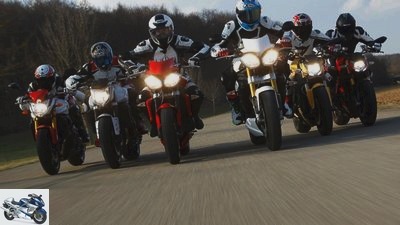
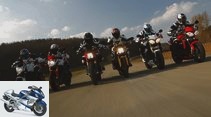
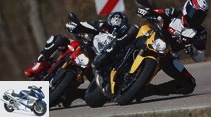
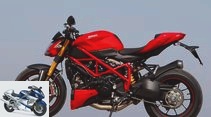
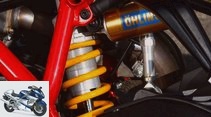
32 photos
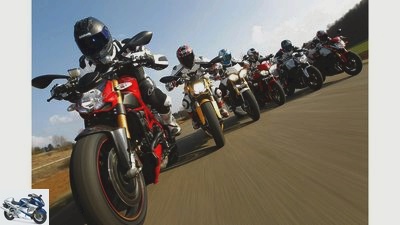
1/32
Ducati Streetfighter S / Streetfighter 848, Triumph Speed Triple R / Street Triple R and Yamaha FZ1 / FZ8 in the naked bike comparison test big versus small.
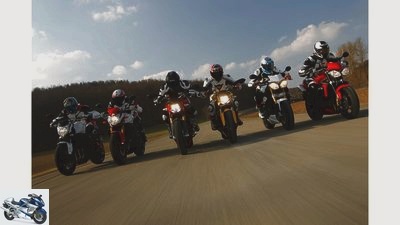
2/32
Yamaha FZ8 / FZ1, Triumph Speed Triple R / Street Triple R and Ducati Streetfighter 848 / Streetfighter S..

3/32
Ducati Streetfighter S / Streetfighter 848.
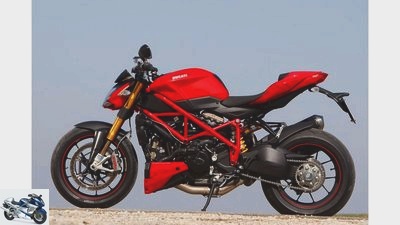
4/32
Ducati Streetfighter S.

5/32
Ducati Streetfighter S: The rear can be raised using the adjustable push rod.
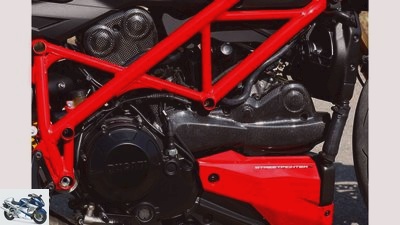
6/32
Ducati Streetfighter S: Even the timing belt cover is made of carbon.
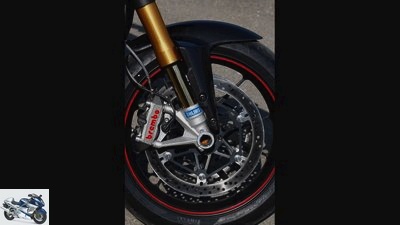
7/32
Ducati Streetfighter S: The “galactic” monoblocks from Brembo.
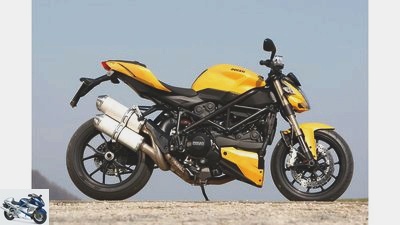
8/32
Ducati Streetfighter 848.

9/32
Ducati Streetfighter 848: The handlebar of the 848, which is mounted far forward.
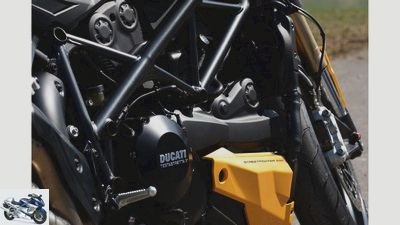
10/32
Ducati Streetfighter 848: Martial-looking technology in a tubular space.
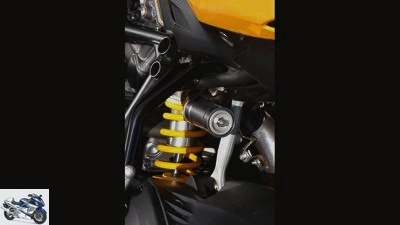
11/32
Ducati Streetfighter 848: High quality, fully adjustable shock absorber – the push rod is unfortunately not adjustable in height.
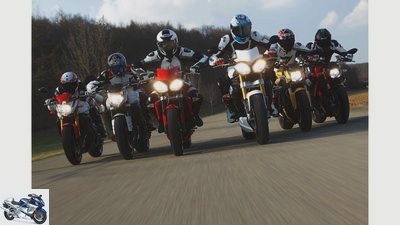
12/32
Yamaha FZ8 / FZ1, Triumph Speed Triple R / Street Triple R and Ducati Streetfighter 848 / Streetfighter S..
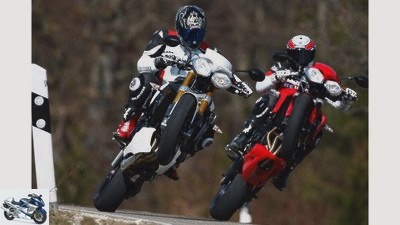
13/32
Triumph Speed Triple R / Street Triple R.
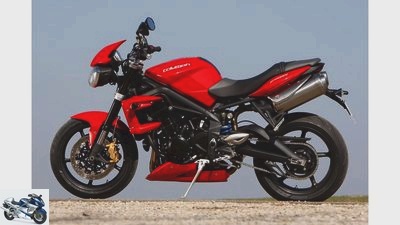
14/32
Triumph Street Triple R..
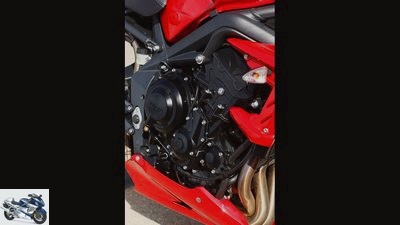
15/32
Triumph Street Triple R: easy-revving, greedy, lively: grandiose middle-class drive of the Streety.
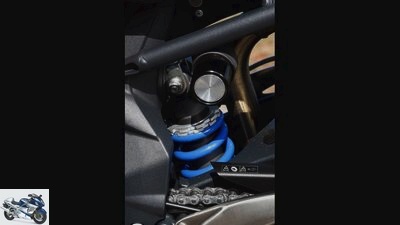
16/32
Triumph Street Triple R: The shock absorber shines with practical set-up and very reasonable response.
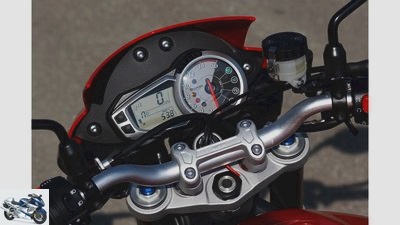
17/32
Triumph Street Triple R: Lap timer and shift light in the cockpit are clear commitments to sport.
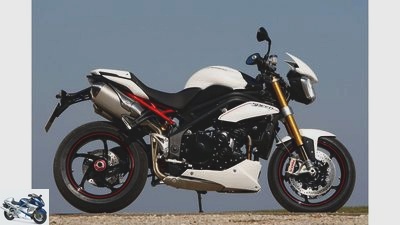
18/32
Triumph Speed Triple R..
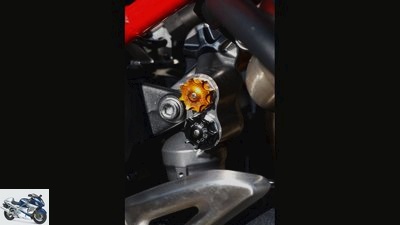
19/32
Triumph Speed Triple R: The TTX shock absorber is clearly too tight for the country road.
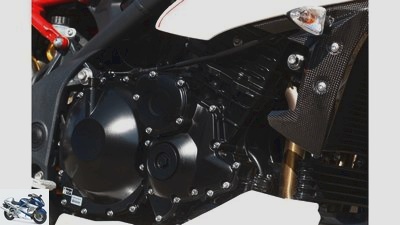
20/32
Triumph Speed Triple R: The 1050 propellant is still a real pearl.
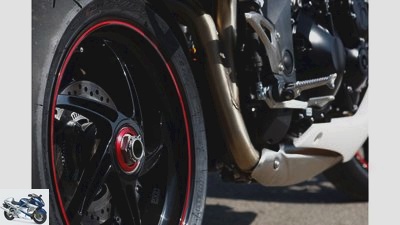
21/32
Triumph Speed Triple R: The seemingly free-floating, shapely rear wheel is a real feast for the eyes.
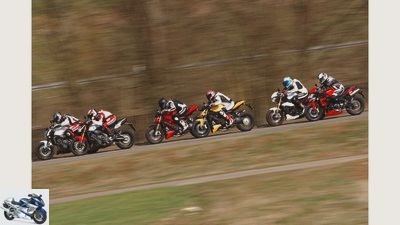
22/32
Yamaha FZ1 / FZ8, Ducati Streetfighter S / Streetfighter 848 and Triumph Speed Triple R / Street Triple R..
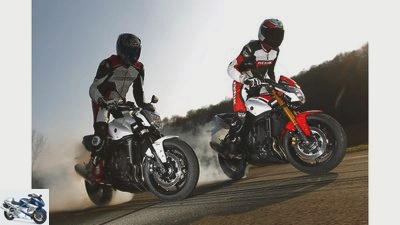
23/32
Yamaha FZ1 / FZ8.
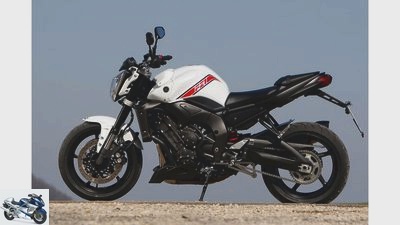
24/32
Yamaha FZ1.
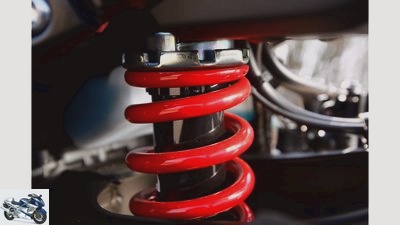
25/32
Yamaha FZ1: shock absorber with adjustable rebound, unfortunately not always sufficient.
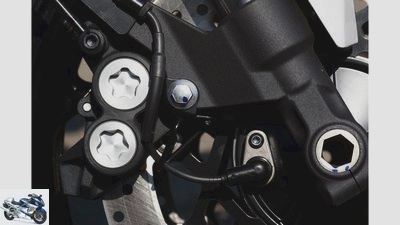
26/32
Yamaha FZ1: The small four-piston calipers and the ABS sensor with a covered tooth lock washer.
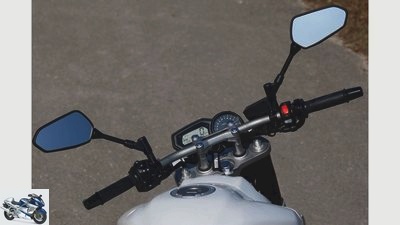
27/32
Yamaha FZ1: Really cool: The not curved handlebar looks more uncomfortable than it is in practice.
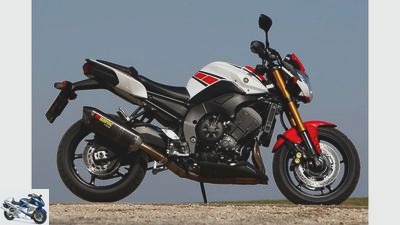
28/32
Yamaha FZ8.
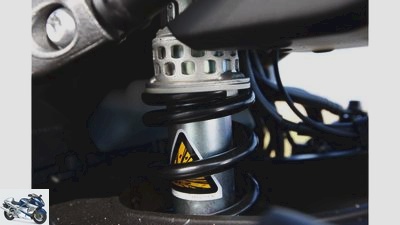
29/32
Yamaha FZ8: shock absorber – apart from the preload without adjustment.
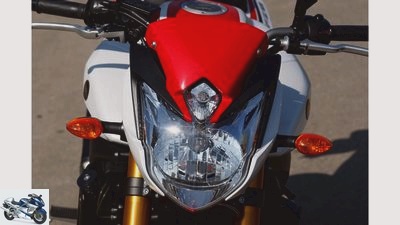
30/32
Yamaha FZ8: The small spoiler on the lamp mask has little effect.
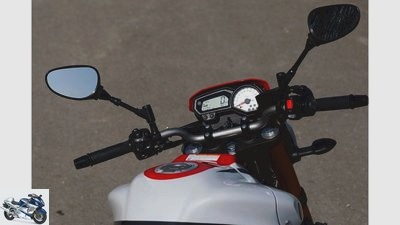
31/32
Yamaha FZ8: Fades cockpit with little information, a gear indicator would be desirable.
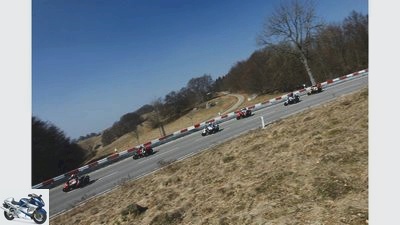
32/32
Ducati Streetfighter 848 / Streetfighter S, Triumph Street Triple R / Speed Triple R and Yamaha FZ8 / FZ1.
Comparison test: naked bikes big versus small
Naked bikes from Ducati, Triumph and Yamaha put to the test
Content of
Sporty, aggressive naked bikes compete in almost all displacement classes. Whether with a Superbike engine, Supersport propellant or the best of both worlds – the double packs from Ducati, Triumph and Yamaha have it all.
D.he wild horde lasciviously makes its way across the country road. Twin roars, three-cylinder rumblings and four-cylinder roars fill the landscape. Spring awakening – in all tones! The sextet is special, because three pairs of siblings not only fight for family honor, but also for who will win the race on the country road. It’s not about seconds – of course not! But the winning factor is clearly measurable.
At the end of the day, the biggest grin wins, because nothing is more important on sporty naked bikes than having fun rocking and swinging. And with the Ducati Streetfighters, the Triumph Triples and the FZ sisters from Yamaha, the right ones are at the start. The hottest country road babe is called.
Ducati: Streetfighter 848 / S
Ducati Streetfighter S / Streetfighter 848.
You never have enough time. The day quickly turned into a sunny March lunchtime, but it will never be long enough. The conditions are great to get going. So up on the “red one”. And it quickly becomes clear: the Ducati Streetfighter S with the fat twin from the ex-Superbike 1098 is a wild bull. Its horns, the 725 millimeter wide handlebar, are so far forward that you could almost believe that you are reaching far over the front wheel.
The thundering two-cylinder sound angrily seduces you to give up your shirt every time you turn the gas. The power is enormous. And that is exactly the hallmark of this naked. For this, running culture is sacrificed, the twin rocks and bucks. Nevertheless, thanks to the light forged wheels and the Pirelli Diablo Rosso Corsa, the large Streetfighter can be bent playfully. The Duc precisely follows the driver’s gaze. The only thing that slows down the fun is the peculiarity of the engine, namely its gruff throttle response. If you are too hesitant to accelerate, you usually miss the ideal line. This Taurus therefore always wants to be guided and controlled with high concentration – the S is an aggro bike of the highest order. Which is why the steering damper is essential, because the S is always on the move with a very light front wheel.
Compared to the other test candidates, the brake is like from another galaxy. If you touch the radial Brembo pump only lightly, the pads of the easy-to-use monoblock stoppers bite into the brake disc and the street fighter delays a record-breaking speed. But be careful: no ABS! Too much of a good thing and you’re lying on the street. In this respect, the S offers aggro in abundance here too.
However, a real problem with the great Streetfighter Duc reveals itself in this context, namely the unfortunate pairing of the brutal brake with the fork. It’s just too soft for such blatant delays. Even with relatively careful application of the brake pads, the front dips deeply in a flash. When driving over the front wheel, this is not an easy exercise even for experienced pilots. To put it in a nutshell: this bike is for experienced guys. If you don’t want to be constantly on your guard during the happy burning, you should rather deal with the 848.
At the hindquarters, however, the Ducatis are considered very tightly tuned. Which the great street fighters also emphatically underpins, because the testers’ intervertebral discs can sing a song of suffering – the rear of the bike is also inharmonious. So the verdict falls: Everything about the S lives up to its name – Streetfighter. Here and there there is even too much of a good thing, she looks like a street fighter who threatens to slide into the illegality of terrorism.
Ducati Streetfighter 848.
The 848 of all things proves that Ducati can do things nicer. It is therefore not the boring version of its rabid big sister, but the more perfectly made bike for the country road with the necessary degree of aggressiveness and willingness to fight. This also signals the pilot’s fighting stance, even if it is more moderate – the handlebars are slightly higher than on the S. But the 848 also has a better trained braking system, less aggressive than on the S, but still light years more effective than that of the competition. The ABS is also missing. But together with the well-coordinated fork, this is simply safer to master.
In general, the vote is very balanced. All testers were enthusiastic about the chassis, because it is really sporty and still relatively comfortable to iron on the country roads. The spring elements of the little Streetfighter also offer adjustable rebound and compression damping, so that the right setting can be found for every route and every driving style.
The little street fighter is simply the most fun. With the thick Pirelli rear tire in special size 180 / 60-17, it can be drifted playfully around corners. The Testastretta engine pushes hard enough for wheelies and sprint races, but above all very evenly. You can accelerate very early at the apex. Thanks to the well-functioning traction control even out of slippery corners.
Both Ducatis still have the much too stiff clutch. We should be able to do better in 2012.
Triumph: Street / Speed Triple R
Triumph Speed Triple R / Street Triple R.
You come from a country where the people still submissively throw themselves in the dust before the monarch. But as so often, offspring of noble origins rebel against the establishment and don’t care about etiquette. Like the two sisters Triumph Street Triple R and Speed Triple R. The “R” in the name stands for a higher quality equipment compared to the respective basic models. Despite or perhaps because of their inappropriateness, British street fighters enjoy an excellent reputation and have many fans. But which of the sympathetic ruffians does the family crown deserve? Does the Speedy, now with “R” and proven brutal power, overtake its extremely successful little sister? Or, thanks to the lower weight, it drives the fat girl around the ears?
A look at the performance diagram creates clear conditions on the engine side. The Big Block of the Speed Triple generates a whopping 134 hp and 111 Nm. In contrast, the little ones’ 108 hooves and 69 Nm seem almost weak-chested. The difference in displacement is also noticeable in the sound. The Speedy growls sonorous and with a full bass from 1050 cubic centimeters, while the 675 of the Street Triple screams shrilly and high-pitched. What both have in common is the hot, greedy three-cylinder sound when accelerating, which repeatedly steals your senses. With this soundscape, one wishes for a life exclusively with completely open throttle valves!
Despite its disadvantage in terms of performance, the Streety remains surprisingly well connected to its muscle-bound relatives. After all, at 220.5 kilograms, it carries exactly 28.5 kilograms more with it than the little sweeper, who weighs just 192 kilograms. When accelerating from 0 to 150 km / h, the Speedy of the Street Triple only drops by five tenths of a second (5.8 to 6.3 seconds). Even when pulling through from 50 to 150 km / h in the last gear, the displacement giant of the small buzzes with 9.4 to 10.1 seconds, only seven tenths. Subjectively, however, there are worlds between the two propellants: bearish and powerful of the 1050, lively and easy to turn the 675.
The big one has an advantage when it comes to throttle response. The load changes not quite as pronounced as the hop, which jumps on the gas very suddenly. The Speedy is also slightly ahead when it comes to operating the gearbox. Thanks to the changed gearshift on the R version, the changes are now a little smoother. The bottom line is what you could have guessed beforehand: the engine rating decides the Speed Triple for itself. However, the little one moves properly on her big sister’s thick fur.
And what about the chassis? To get it straight: Speedy wins this chapter too. But it owes this exclusively to its ABS, since the British do not offer an anti-lock device for the Street Triple. Without this system, the Streety would be clearly ahead on the chassis side. Sometimes, however, the switchable ABS of the fat ones weakens a little, because during the control process it builds up the brake pressure only very slowly. What both stoppers have in common is the slightly degressive effect. This means that the brake bites heavily at first and the effect diminishes shortly afterwards with the same brake pressure. Neither is bad, but it can be felt.
Triumph Street Triple R..
Of course, the driver feels the mercilessly hard setup of the Speed Triple R more clearly. Front and rear it was much too tight for the country road. The truck stumbles from edge to edge on a wrinkled track, comfort is zero. The superb responsiveness, especially of the shock absorber, is of no use either. The vote belongs to the race, that’s it! Streety does a lot better. Appropriate spring rates and correct damping, acceptable response behavior: the Street Triple chassis is clearly the better choice for public areas.
In addition, it scurries quickly around the radii and takes alternating curves in a storm – simply fantastic! Naturally, the Speedy rolls a little more sedate through the corners – the larger mass sends its regards. In addition, there are the high gyroscopic forces of the massive crankshaft, which also rob the great Triumph of handling. The fat 190 mm roller on a six-inch rim does the rest. To save her honor, it should be said that she hunts extremely precisely, very stable and extremely neutral around the curves. In this discipline, she is ahead of the street again. Both blue blooded animals have their advantages and quirks – just like in real life.
Yamaha: FZ8 / FZ1
Yamaha FZ1 / FZ8.
After Italy and Great Britain now the naked sisters from Nippon. A tempting pair are the R1 offshoot FZ1 and the 800 cubic intermediate size of the FZ8. Get on the saddle, and the 104 Nm strong power plant of the big ones buzzes gently. The four-cylinder pushes forward with pressure from the middle. Oops! Otherwise the FZ1 was seen as a speed-hungry bitch that has more of a superbike character than a country road. And now? At 45 km / h in the last gear, which unfortunately is not displayed in the somewhat bland cockpit, the tall naked woman accelerates out of the city without noticeable stagnation. Wonderfully lazy to switch, it can be snaked through the increasing traffic. Has Yamaha been quietly optimizing? Seems so. Even on the country road, the unusual virtue of the engine will always cause people to shake their heads in disbelief – in the best sense of the word. Nevertheless, the yield between 3000 and 6000 rpm is a little too little compared to the other two big bikes in this test, there is still too much power at the upper end of the revs. The draft values speak a clear language.
But first the Autobahn. This stage at 245 km / h is absolutely not recommended with a backpack and thick jacket. Like an overpowering hurricane, the wind almost pulls you off your bike. The comfort zone of the FZ1 is clearly between 80 and 160 km / h, in which the engine also gently does its job. The feeling of sitting is good. Active on the wide handlebars you look forward to the upcoming cornering. In the end, the hard bench should make itself a bit uncomfortable on the very bottom, but well.
The curves lurking after the motorway exit can be hit perfectly and precisely with the big Yamaha – despite the old first tires of the Dunlop D 211 A type. On the well-developed main road, that slips off really well. The one-liter whisk follows the commands of the driver with agility. On bad country roads, however, it is no longer so fun. Despite attempts to adjust, the big Yamaha swings back a lot and you often lift off the saddle. On our test track, it even goes to the block. Under tension you sometimes have to survive nasty kickbacks on the 1000 meter. Unfortunately, the Yamaha naked bike does not have a steering damper such as the Ducati Streetfighter S offers for such cases.
If the fork of the FZ1 can be adjusted in rebound and compression and the shock absorber can be adjusted in the rebound, which means that you can find a suitable setting for a decent driving style, the screwdriver looks in vain for such adjustment options on the FZ8. The sharp Japanese red pencil rules here. Otherwise, the little one has many assemblies in common with that of her big sister. The frame, swing arm, cockpit and even the ABS system are identical. The anti-lock device fits the Yamahas perfectly. Not too biting, you can always come to a standstill quickly and safely with moderate hand strength.
Yamaha FZ8.
On the engine side, the two sisters share the good running smoothness and the beautiful responsiveness. The gearboxes are the best in the test field for both. The engine of the FZ8 is of course not as high-torque as that of the 1000 series. The smaller engine often even seems listless, so unemotional it gets down to business, and with the poor punch it is more reminiscent of a 600. But due to the smaller engine, the FZ8 can be turned much more easily. The lower crankshaft weight, ergo the lower rotating masses, are clearly noticeable.
Back in the city, both Japanese women slide quickly through the traffic. It’s great fun to cheat annoyed drivers and meander through the traffic jams. Yamaha has equipped both FZs with Akrapovic mufflers from the range of accessories. Fine, because through this sonorous, but not intrusive soundscape, the whole thing is accompanied by species-appropriate.
Both of the massive appearances are good for showing off. The FZ1 is also very good at wheeling. A quick burst of gas is enough and you can burn for miles on your rear wheel through the prairie. Unfortunately, that doesn’t work with the smaller Yamaha and underlines its essence: Everything works at a good level, but it leaves the euphoria to the others.
Technical data: Ducati
Ducati Streetfighter S.
Ducati Streetfighter S
drive
Two-cylinder 90-degree V-engine, four valves / cylinder, 114 kW (155 PS) at 9500 / min *, 115 Nm at 9500 / min *, 1099 cm3, bore / stroke 104.0 / 64.7 mm, Compression ratio 12.5: 1, ignition / injection system, 60 mm throttle valves, hydraulically operated multi-plate dry clutch, six-speed gearbox, G-Kat
landing gear
Steel tubular space frame, steering head angle: 64.4 degrees, caster: 114 mm, wheelbase: 1475 mm. Upside-down fork, Ø fork inner tube: 43 mm, adjustable in spring base, rebound and compression. Central spring strut with deflection, adjustable in spring base, rebound and compression. Suspension travel front / rear: 120/127 mm
Wheels and brakes
Forged light alloy wheels, 3.50 x 17 / 6.00 x 17, front tires: 120/70 ZR 17, rear: 190/55 ZR 17. Initial tires: Pirelli Diablo Corsa III, 330 mm double disc brakes with radially screwed four-piston Fixed calipers and radial brake pump at the front, 245 mm single disc with two-piston fixed caliper at the rear
measurements and weight
Length / width / height 2140/925/1135 mm, seat / handlebar height 840/965 mm, handlebar width 730 mm, 198 kg fully fueled, f / r 48.0 / 52.0%
Rear wheel power in last gear
109 kW (148 PS) at 246 km / h
consumption
Fuel type: Super unleaded. Average test consumption: 6.7 liters / 100 km, tank capacity: 16.5 liters, range: 246 km
Base price
18 700 euros (plus ancillary costs)
Ducati Streetfighter 848
drive
Two-cylinder 90-degree V-engine, four valves / cylinder, 97 kW (132 PS) at 10,000 rpm *, 94 Nm at 9500 rpm *, 849 cm³, bore / stroke: 94.0 / 61.2 mm, compression ratio: 13.2: 1, ignition / injection system, 60 mm throttle valves, hydraulically operated multi-disc oil bath clutch, six-speed gearbox, G-Kat, chain
landing gear
Steel tubular space frame, steering head angle: 64.5 degrees, caster: 103 mm, wheelbase: 1475 mm, upside-down fork, Ø fork inner tube: 43 mm, adjustable spring base, rebound and compression stage. Central spring strut with deflection, adjustable in spring base, rebound and compression. Suspension travel front / rear: 127/127 mm
Wheels and brakes
Light alloy cast wheels, 3.50 x 17 / 5.50 x 17, front tires: 120/70 ZR 17, rear: 180/60 ZR 17, first tires: Pirelli Diablo Rosso Corsa, 320 mm double disc brakes with radially attached four-piston fixed calipers at the front, 245 -mm single disc with two-piston fixed caliper at the rear
measurements and weight
Length / width / height: 2090/880/1170 mm, seat / handlebar height: 840/990 mm, handlebar width: 730 mm, 201 kg fully fueled, v./h .: 48.3 / 51.7%
Rear wheel power in last gear
89 kW (121 PS) at 232 km / h
consumption
Fuel type: Super unleaded. Average test consumption: 7.4 liters / 100 km, tank capacity 16.5 liters, range: 223 km
Base price
12 190 euros (plus additional costs)
Technical data: Triumph
Triumph Speed Triple R..
Triumph Speed Triple R.
drive
Three-cylinder in-line engine, four valves / cylinder, 99 kW (135 PS) at 9400 / min *, 111 Nm at 7750 / min *, 1050 cm³, bore / stroke: 79.0 / 71.4 mm, compression ratio: 12 , 0: 1, ignition / injection system, 46 mm throttle valves, mechanically operated multi-plate oil bath clutch, six-speed gearbox, G-Kat, chain
landing gear
Light alloy bridge frame, steering head angle: 67.2 degrees, caster: 91 mm, wheelbase: 1435 mm, upside-down fork, Ø fork inner tube: 43 mm, adjustable in spring base, rebound and compression. Central spring strut with deflection, adjustable in spring base, rebound and compression. Suspension travel front / rear: 120/130 mm
Wheels and brakes
Forged light alloy wheels, 3.50 x 17 / 6.00 x 17, front tires: 120/70 ZR 17, rear: 190/55 ZR 17, test tires: Diablo Supercorsa SP, 320 mm double disc brakes with radially screwed four-piston fixed calipers at the front, 255 mm single disc with two-piston floating caliper at the rear, ABS
measurements and weight
Length / width / height: 2150/880/1230 mm *, seat / handlebar height: 830/1015 mm, handlebar width: 735 mm, 221 kg fully fueled, v./h .: 50.0 / 50.0%
Rear wheel power in last gear
92.5 kW (126 PS) at 240 km / h
consumption
Fuel type: Super unleaded. Average test consumption: 6.4 liters / 100 km, tank capacity 17.5 liters, range: 273 km
Base price
14 990 euros (plus ancillary costs)
Triumph Street Triple R.
drive
Three-cylinder in-line engine, four valves / cylinder, 78 kW (106 HP) at 11,700 / min *, 68 Nm at 9200 / min *, 675 cm³, bore / stroke: 74.0 / 52.3 mm, compression ratio: 12.7: 1, ignition / injection system, 44 mm throttle valves, mechanically operated multi-plate oil bath clutch, six-speed gearbox, G-Kat, chain
landing gear
Light alloy bridge frame, steering head angle: 66.1 degrees, caster: 93 mm, wheelbase: 1405 mm, upside-down fork, Ø fork inner tube: 41 mm, adjustable spring base, rebound and compression level. Central spring strut with deflection, adjustable in spring base, rebound and compression. Suspension travel front / rear: 120/130 mm
Wheels and brakes
Cast light alloy wheels, 3.50 x 17 / 5.50 x 17, front tires: 120/70 ZR 17, rear: 180/55 ZR 17, first tires: Pirelli Diablo Rosso, 308 mm double disc brakes with radially attached four-piston fixed calipers at the front, 220- mm single disc with single-piston floating caliper at the rear
measurements and weight
Length / width / height: 2100/860/1250 mm *, seat / handlebar height: 830/1010 mm, handlebar width: 725 mm, 190 kg fully fueled, v./h .: 51.0 / 49.0%
Rear wheel power in last gear
74.5 kW (101 PS) at 215 km / h
consumption
Fuel type: Super unleaded. Average test consumption: 6.8 liters / 100 km, tank capacity 17.4 liters, range: 256 km
Base price
9090 Euro (plus ancillary costs)
Technical data: Yamaha
Yamaha FZ1.
Yamaha FZ8
drive
Four-cylinder in-line engine, four valves / cylinder, 78 kW (106 HP) at 10000 / min *, 82 Nm at 8500 / min *, 779 cm³, bore / stroke: 68.0 / 53.6 mm, compression ratio: 12.0 : 1, ignition / injection system, 35 mm throttle valves, mechanically operated multi-disc oil bath clutch, six-speed gearbox, G-Kat, chain
landing gear
Light alloy bridge frame, steering head angle: 65.0 degrees, caster: 109 mm, wheelbase: 1460 mm, upside-down fork, Ø fork inner tube: 43 mm. Central spring strut with deflection, adjustable in the spring base. Suspension travel front / rear: 130/130 mm
Wheels and brakes
Cast light alloy wheels, 3.50 x 17 / 5.50 x 17, front tires: 120/70 ZR 17, rear: 180/55 ZR 17, test tires: Bridge-stone BT 21 in “BB”, 310 mm double disc brakes with four-piston locking -Saddles in front, 267 mm single disc with single-piston floating caliper in rear, ABS
measurements and weight
Length / width / height: 2012/840/1270 mm, seat / handlebar height: 805/1005 mm, handlebar width: 695 mm, 213 kg fully fueled, v./h .: 51.1 / 48.9%
Rear wheel power in last gear
69.1 kW (94 PS) at 208 km / h
consumption
Fuel type: Super unleaded. Average test consumption: 6.6 liters / 100 km, tank capacity 17.0 liters, range: 258 km
Base price
8495 euros (plus utilities plus 637 euros for Akrapovic muffler)
Yamaha FZ1
drive
Four-cylinder in-line engine, four valves / cylinder, 110 kW (150 PS) at 11,000 / min *, 106 Nm at 8,000 / min *, 998 cm3, bore / stroke 77.0 / 53.6 mm, compression ratio 11.5: 1, ignition / injection system, 42 mm throttle valves, mechanically operated multi-disc oil bath clutch, six-speed gearbox, G-Kat
landing gear
Light metal bridge frame, steering head angle: 65.0 degrees, caster: 109 mm, wheelbase: 1460 mm, upside-down fork, Ø fork inner tube: 43 mm, adjustable spring base, rebound and compression level. Central spring strut with deflection, adjustable in spring base, rebound and compression. Suspension travel front / rear: 130/130 mm
Wheels and brakes
Light alloy cast wheels, 3.50 x 17 / 6.00 x 17, front tires: 120/70 ZR 17, rear: 190/50 ZR 17. First tires: Dunlop D 221 “A” / “G”, 320 mm double disc brakes with four-piston Fixed calipers at the front, 255 mm single disc brakes with single-piston floating calipers at the rear
measurements and weight
Length / width / height: 2119/800/1240 mm, seat / handlebar height: 800/1010 mm, handlebar width: 685 mm, 219 kg with a full tank, v./h .: 50.7 / 49.3%
Rear wheel power in last gear
97 kW (132 PS) at 267 km / h
consumption
Fuel type: Super unleaded, average test consumption: 7.3 liters / 100 km, tank capacity 18 liters, range: 247 km
Base price
11 195 euros (plus Nk plus 676 euros for Akrapovic muffler)
Related articles
-
Triumph Street Triple R, Honda Hornet 600 and Ducati Monster 1100 Evo in the test
fact 17th photos fact 1/17 The Triumph Street Triple R, Honda Hornet 600 and the Ducati Monster 1100 Evo compete against each other. Which of them is the…
-
Ducati Hypermotard, MV Agusta Rivale 800, Yamaha MT-09 Street Rally in the test
Bilski 33 photos Bilski 1/33 Supermotos? Do the Ducati Hypermotard, MV Agusta Rivale 800 and the Yamaha MT-09 Street Rally really still pass as…
-
Comparative test: large displacement naked bikes
37 photos 1/37 In comparison: Benelli TnT 160 R, Honda CB 1000 R, MV Agusta Brutale 1090 RR and Triumph Speed Triple….
-
Comparison test: Honda CB 1000 R, Yamaha FZ1, Triumph Speed Triple, Kawasaki Z 1000
Comparison test: Honda CB 1000 R, Yamaha FZ1, Triumph Speed Triple, Kawasaki Z 1000 Large naked bikes in comparison Content of At its…
-
Comparison test: Ducati Diavel, Suzuki B-King and Yamaha Vmax
Jahn Comparison test: Power Bikes 2011 Ducati Diavel, Suzuki B-King and Yamaha Vmax Content of Big appearance, powerful sound waves, pressure from all…
-
Comparison test: power naked bikes on the racetrack
Comparison test: naked bikes on the racetrack Country road fighter on the racetrack Content of It has to be extreme – that shows what is…
-
Yamaha, Triumph and Suzuki 600 super sports cars in comparison test
fact 600 super sports car 2011 from Yamaha, Triumph and Suzuki Test: Yamaha YZF-R6, Triumph Daytona 675 R, Suzuki GSX-R 600 Content from 2011 is the year …
-
Comparison test of naked bikes
Naked bike comparison test 2011: Ducati, Kawasaki and Triumph The triumph of the new Speed Triple Content of Triumph strikes back. After…
-
BMW, Ducati, Suzuki and Triumph super sports cars in a comparison test
29 photos 1/29 Triumph Daytona 675, Ducati 848 Evo Corse SE, BMW S 1000 RR, Suzuki GSX-R 750. Different bikes – different cubic…
-
Comparative test of athletes naked bikes
Jahn Comparison test athletes / naked bikes Frontier workers While modern naked bikes are getting sharper, the flawless athletes have long been able to…